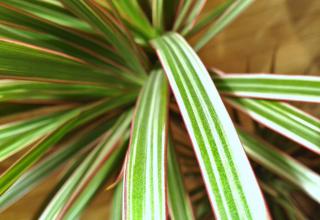

Dracaena marginata ‘bicolor’ is a special variety of dragon plant. Deep green leaves are lined with a thin, elegant strand of bordeaux red, encasing bands of emerald green and ivory yellow.
Dracaena marginata bicolor facts
Name – Dracaena reflexa var. angustifolia ‘bicolor’
Horticultural name – Dracaena marginata
Family – Agavoidaea
Height – 3 to 6 feet (100 to 200 cm)
Type – indoor plant, houseplant
Exposure – full sun, well-lit
Soil – potting soil mix, well-draining
Foliage – evergreen
Just like other varieties of Dracaena marginata, the ‘bicolor’ variety can be grown indoors in containers all year round.
In a pot or container, your Dracaena marginata bicolor simply requires:
You’ll need to provide fresh nutrients every two or three years in the form of new soil mix. You can either repot your dracaena or topdress it.
Soil quality isn’t so important because nutrients will always seep in from further off. What is important is to ensure your Dracaena marginata bicolor doesn’t stay steeped in clay, waterlogged soil.

Cuttings is by far the simplest manner of reproducing your favorite Dracaena marginata bicolor.
Making cuttings and cutting the top off your dracaena is the surest way to replicate your Dracaena marginata bicolor with the exact same properties as the mother plant. In effect, it is a form of cloning.
The most important problem that Dracaena plants face is almost always overwatering.
If you’re prone to visiting your plants with water daily, here’s a simple trick. It deals with overwatering (which causes yellow leaves) and insufficient air moisture.
The ‘bicolor’ Dracaena marginata variety has a distinctive thin red margin to each side of the leaves. In the center, one or more pale yellow bands alternate with green.
It has slightly less green chlorophyll in these portions of the leaves. This means it won’t be as vigorous as other all-green D. marginata cultivars.
However, it will still be more vigorous than the Dracaena marginata ‘Colorama’, ‘Kiwi’, and ‘Tricolor’ varieties. These have even less sun-processing chlorophyll cells. They require even more light.
Like most Dracaena plants, Dracaena marginata ‘bicolor’ comes from tropical countries like Costa Rica and other places along the Caribbean. The perfect temperature and moisture settings of those regions make it easier to have large plantations. Scores of cuttings grow there for export.
Such imports are occasionally infected with local pests. Each might trigger diseases on Dracaena marginata ‘bicolor’ and other houseplants, like scale insects or mealy bugs, spider mite and more.
In tropical countries, Dracaena marginata often grows in the wild, whether in its native habitat or because it was introduced there. In the wild, Dracaena marginata can grow very tall.
Read more about Dracaena marginata cultivars:
If you’ve got several varieties of Dracaena marginata growing together, check how much “green” their leaves have. Place less green varieties closer to full light. Leave Dracaena marginata bicolor at a slight disadvantage.
Since it’s more vigorous, you’ll be evening growth out between varieties.